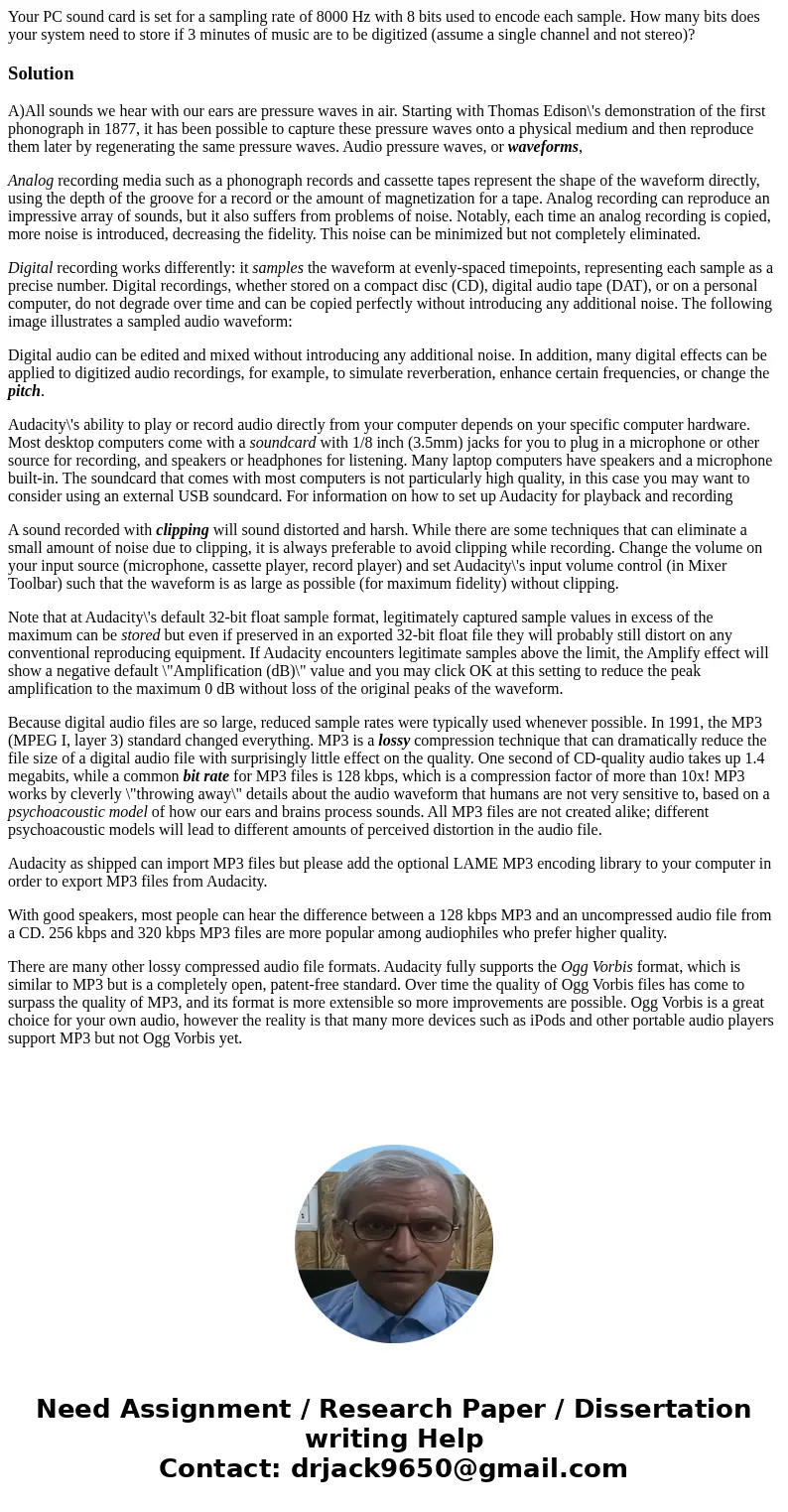Your PC sound card is set for a sampling rate of 8000 Hz wit
Your PC sound card is set for a sampling rate of 8000 Hz with 8 bits used to encode each sample. How many bits does your system need to store if 3 minutes of music are to be digitized (assume a single channel and not stereo)?
Solution
A)All sounds we hear with our ears are pressure waves in air. Starting with Thomas Edison\'s demonstration of the first phonograph in 1877, it has been possible to capture these pressure waves onto a physical medium and then reproduce them later by regenerating the same pressure waves. Audio pressure waves, or waveforms,
Analog recording media such as a phonograph records and cassette tapes represent the shape of the waveform directly, using the depth of the groove for a record or the amount of magnetization for a tape. Analog recording can reproduce an impressive array of sounds, but it also suffers from problems of noise. Notably, each time an analog recording is copied, more noise is introduced, decreasing the fidelity. This noise can be minimized but not completely eliminated.
Digital recording works differently: it samples the waveform at evenly-spaced timepoints, representing each sample as a precise number. Digital recordings, whether stored on a compact disc (CD), digital audio tape (DAT), or on a personal computer, do not degrade over time and can be copied perfectly without introducing any additional noise. The following image illustrates a sampled audio waveform:
Digital audio can be edited and mixed without introducing any additional noise. In addition, many digital effects can be applied to digitized audio recordings, for example, to simulate reverberation, enhance certain frequencies, or change the pitch.
Audacity\'s ability to play or record audio directly from your computer depends on your specific computer hardware. Most desktop computers come with a soundcard with 1/8 inch (3.5mm) jacks for you to plug in a microphone or other source for recording, and speakers or headphones for listening. Many laptop computers have speakers and a microphone built-in. The soundcard that comes with most computers is not particularly high quality, in this case you may want to consider using an external USB soundcard. For information on how to set up Audacity for playback and recording
A sound recorded with clipping will sound distorted and harsh. While there are some techniques that can eliminate a small amount of noise due to clipping, it is always preferable to avoid clipping while recording. Change the volume on your input source (microphone, cassette player, record player) and set Audacity\'s input volume control (in Mixer Toolbar) such that the waveform is as large as possible (for maximum fidelity) without clipping.
Note that at Audacity\'s default 32-bit float sample format, legitimately captured sample values in excess of the maximum can be stored but even if preserved in an exported 32-bit float file they will probably still distort on any conventional reproducing equipment. If Audacity encounters legitimate samples above the limit, the Amplify effect will show a negative default \"Amplification (dB)\" value and you may click OK at this setting to reduce the peak amplification to the maximum 0 dB without loss of the original peaks of the waveform.
Because digital audio files are so large, reduced sample rates were typically used whenever possible. In 1991, the MP3 (MPEG I, layer 3) standard changed everything. MP3 is a lossy compression technique that can dramatically reduce the file size of a digital audio file with surprisingly little effect on the quality. One second of CD-quality audio takes up 1.4 megabits, while a common bit rate for MP3 files is 128 kbps, which is a compression factor of more than 10x! MP3 works by cleverly \"throwing away\" details about the audio waveform that humans are not very sensitive to, based on a psychoacoustic model of how our ears and brains process sounds. All MP3 files are not created alike; different psychoacoustic models will lead to different amounts of perceived distortion in the audio file.
Audacity as shipped can import MP3 files but please add the optional LAME MP3 encoding library to your computer in order to export MP3 files from Audacity.
With good speakers, most people can hear the difference between a 128 kbps MP3 and an uncompressed audio file from a CD. 256 kbps and 320 kbps MP3 files are more popular among audiophiles who prefer higher quality.
There are many other lossy compressed audio file formats. Audacity fully supports the Ogg Vorbis format, which is similar to MP3 but is a completely open, patent-free standard. Over time the quality of Ogg Vorbis files has come to surpass the quality of MP3, and its format is more extensible so more improvements are possible. Ogg Vorbis is a great choice for your own audio, however the reality is that many more devices such as iPods and other portable audio players support MP3 but not Ogg Vorbis yet.

 Homework Sourse
Homework Sourse